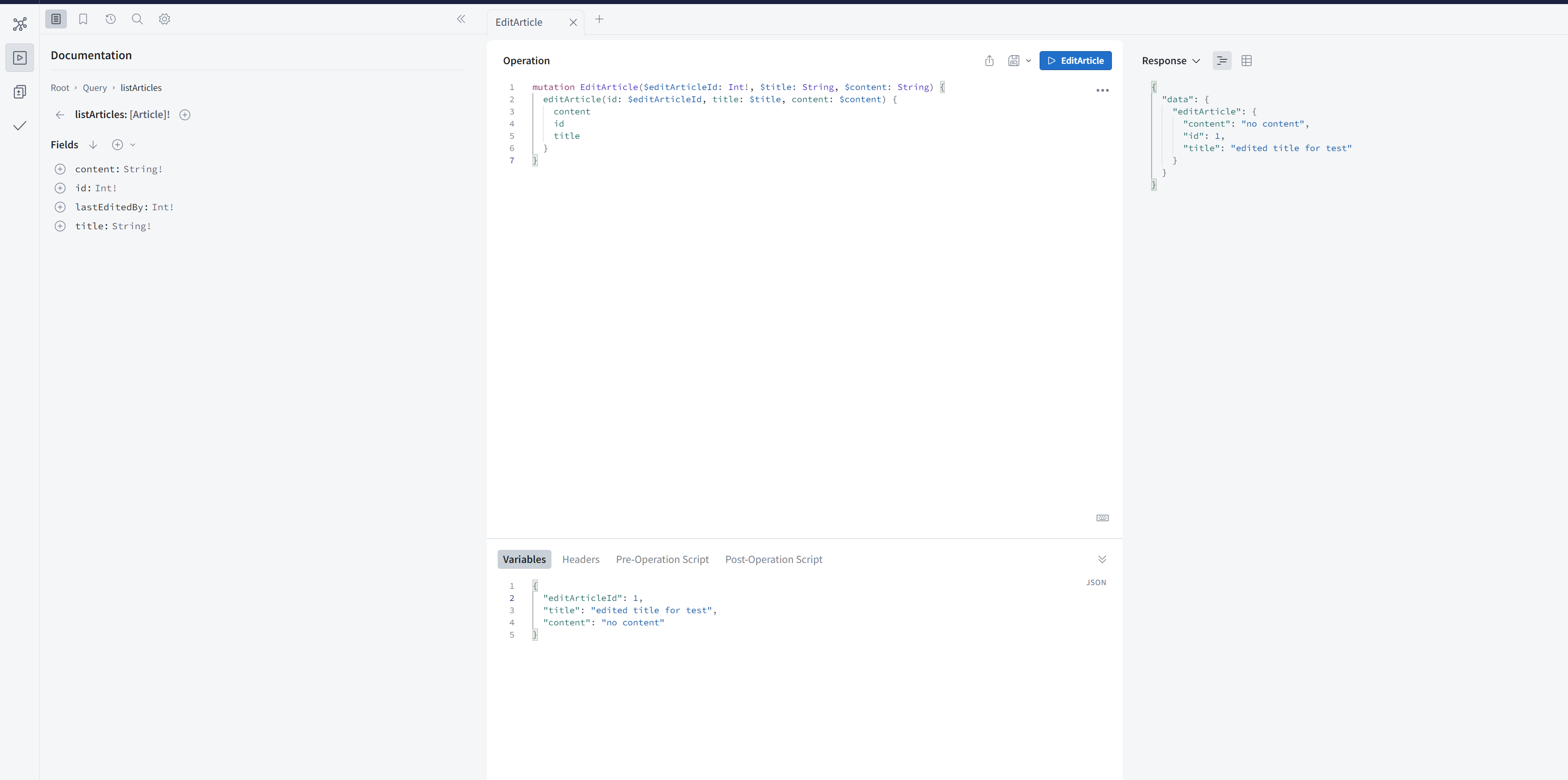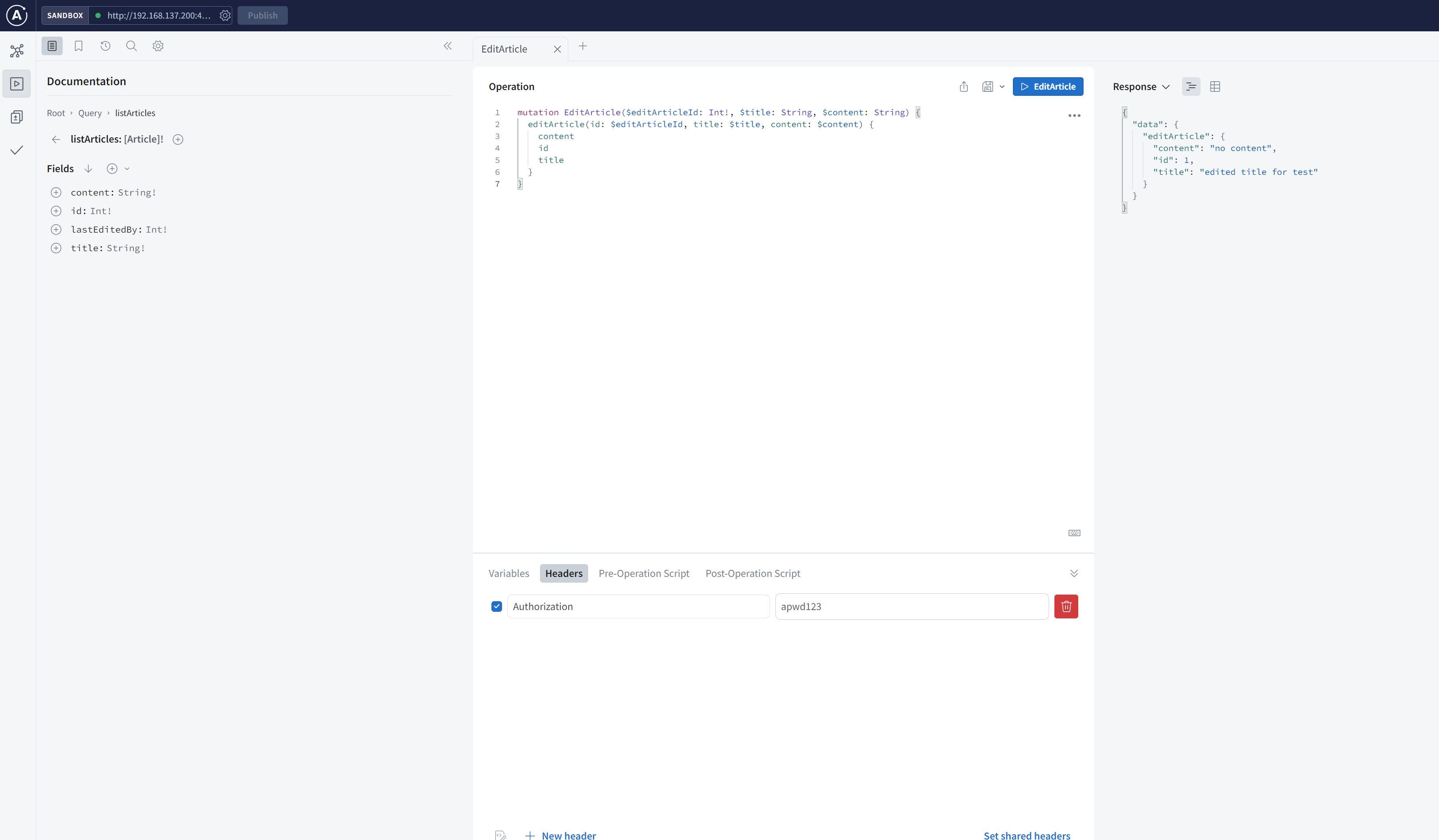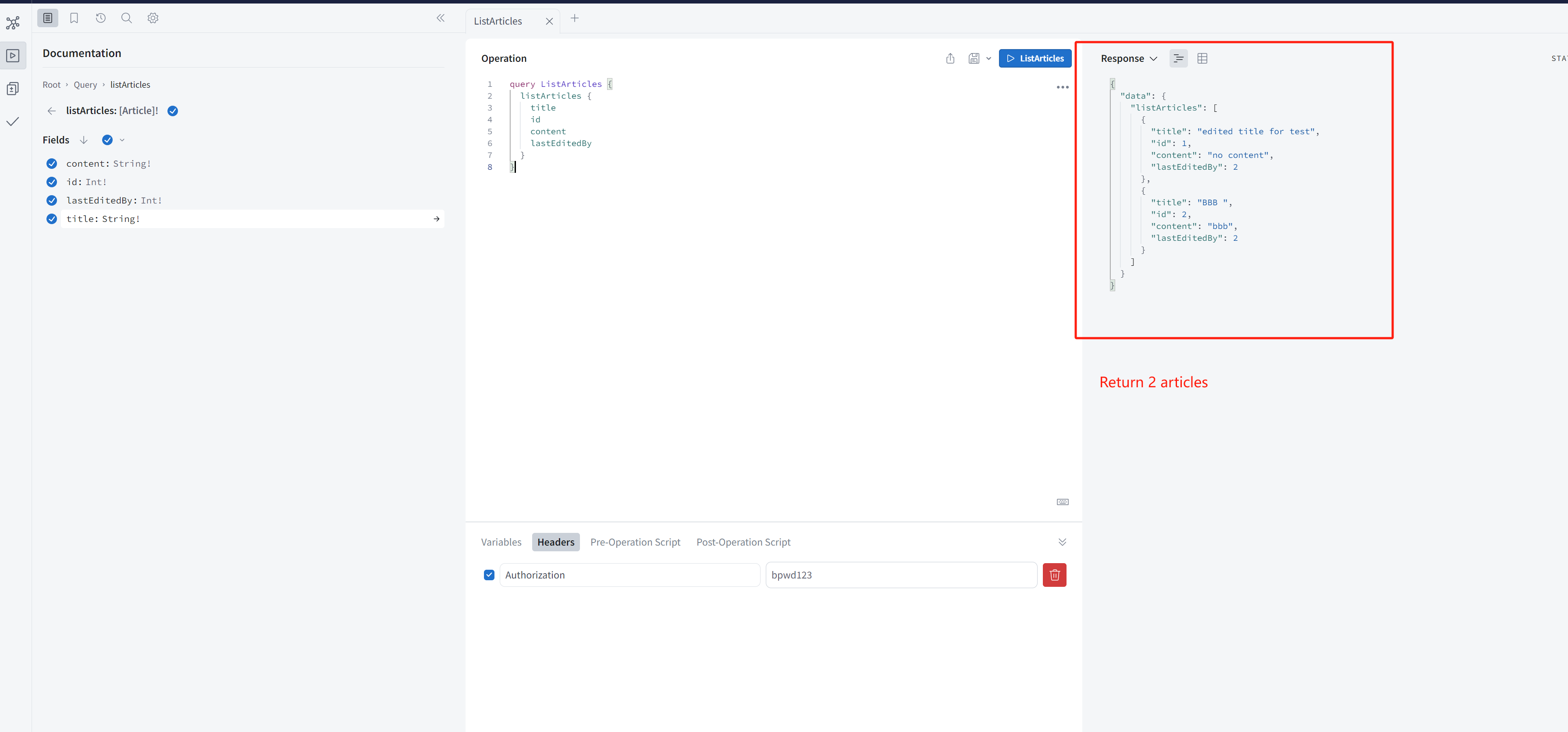What you will learn after reading this Link to heading
- start a Apollo GraphQL(NodeJS) server with typescript.
- add auth guard to server shared context.
Step by step to create a nodejs(typescript) proeject. Link to heading
mkdir quick-start
cd quick-start
npm init --yes && npm pkg set type="module"
npm install --save-dev typescript @types/node nodemon
npm install @apollo/server graphql dotenv dataloader
touch tsconfig.json
paste the following content to tsconfig.json
{
"compilerOptions": {
"rootDirs": ["src"],
"outDir": "dist",
"lib": ["es2020"],
"target": "es2020",
"module": "esnext",
"moduleResolution": "node",
"esModuleInterop": true,
"types": ["node"]
}
}
touch nodemon.json
// content in nodemon.json
{
"watch": [
"src",
".env"
],
"ext": ".ts",
"ignore": [
"src/**/*.spec.ts"
],
"exec": "npm start"
}
now all the frameworks thins are done, let’s to add the first graphql code.
Try to add Article and UserDataSource graphql service code
Link to heading
mkdir src
touch src/index.ts
add the following content to src/index.ts
import { ApolloServer } from '@apollo/server';
import { startStandaloneServer } from '@apollo/server/standalone';
import { GraphQLError } from 'graphql';
import DataLoader from 'dataloader';
class UserDataSource {
constructor() {
}
demoUsers = [
{ username: 'admin', id: 1, token: 'adpwd123', roles: ['admin', 'editor'] },
{ username: 'alice', id: 2, token: 'apwd123', roles: ['editor'] },
{ username: 'bob', id: 3, token: 'bpwd123', roles: ['reader'] },
];
private batchUsers = new DataLoader(async (token: string[]) => {
const productIdToProductMap = this.demoUsers.reduce((mapping, user) => {
mapping[user.token] = user;
return mapping;
}, {});
return token.map((token) => productIdToProductMap[token]);
});
async getUserFor(token) {
return this.batchUsers.load(token);
}
}
export const typeDefs = `#graphql
type Article {
title: String!
id: Int!
content: String!
lastEditedBy: Int!
}
type Query {
listArticles: [Article]!
}
type Mutation {
editArticle(id: Int!, title: String, content: String): Article
}
`;
export const resolvers = {
Query: {
listArticles: async (parent, args, { user, dataSources }, info) => {
return dataSources.article.listArticles(user);
},
},
Mutation: {
editArticle: async (parent, args, { user, dataSources }, info) => {
if (!user) throw new GraphQLError('401 Unauthorized', {
extensions: {
code: 'Unauthorized',
},
});
if (!user.roles.includes('admin') && !user.roles.includes('editor')) {
throw new GraphQLError('403 Forbidden', {
extensions: {
code: 'Forbidden',
},
});
}
return dataSources.article.editArticle({ id: args.id, title: args.title, content: args.content }, user);
},
}
}
Authentication and Authorization Link to heading
Mutation: {
editArticle: async (parent, args, { user, dataSources }, info) => {
if (!user) throw new GraphQLError('401 Unauthorized', {
extensions: {
code: 'Unauthorized',
},
});
if (!user.roles.includes('admin') && !user.roles.includes('editor')) {
throw new GraphQLError('403 Forbidden', {
extensions: {
code: 'Forbidden',
},
});
}
return dataSources.article.editArticle({ id: args.id, title: args.title, content: args.content }, user);
},
}
Authentication: you must log in and show the valid token to do some operations.Authorization: you must have permission to do some operations, for example, system admin can delete a user account but a normal user can not delete account.
the sample Mutation is a good example to show Authentication and Authorization both.
- if no user found in
Context, it return 401. - if user is not
editororadmin, it return 403, that means this user can not edit article.
Add ACL and ArticleDataSource
Link to heading
here a advanced concept Access-control list
class ACL {
hasPermission = (item: { acl }, user: { roles }, operation: 'read' | 'write') => {
if (!item.acl) return true;
if (item.acl['*'][operation] == true) {
return true;
}
if (!user.roles) return false;
user.roles.forEach(role => {
const roleKey = `role:${role}`;
if (roleKey in item.acl && item.acl[`role:${role}`][operation] == true) return true;
});
return false;
};
hasRole = (user: { roles }, roles: []) => {
return roles.some(item => user.roles.includes(item));
}
}
const demoArticles = [
{
title: 'AAA', id: 1, content: 'aaa', lastEditedBy: 2,
acl: {
"*": { read: true },
"role:editor": {
read: true,
write: true
},
"role:admin": {
read: true,
write: true
},
}
},
{
title: 'BBB ', id: 2, content: 'bbb', lastEditedBy: 2,
acl: {
"*": { read: true },
"role:editor": {
read: true,
write: true
},
}
},
{
title: 'CCC', id: 3, content: 'ccc', lastEditedBy: 2,
acl: {
"*": { read: false },
"role:admin": {
read: true,
write: true
},
}
},
];
class ArticleDataSource {
acl: ACL;
constructor(acl: ACL) {
this.acl = acl;
}
private batchArticles = new DataLoader(async (ids: number[]) => {
const productIdToProductMap = demoArticles.reduce((mapping, article) => {
mapping[article.id] = article;
return mapping;
}, {});
return ids.map((id) => productIdToProductMap[id]);
});
async getArticleFor(id) {
return this.batchArticles.load(id);
}
async listArticles(user: { roles }) {
return demoArticles.filter(article => {
return this.acl.hasPermission(article, user, 'read');
});
}
async editArticle(article, user) {
this.batchArticles.clear(article.id);
const foundIndex = demoArticles.findIndex(x => x.id == article.id);
if (foundIndex < 0) throw new GraphQLError('404 Not Found', {
extensions: {
code: 'Not Found',
},
})
const foundItem = demoArticles[foundIndex];
foundItem.lastEditedBy = user.id;
foundItem.content = article.content;
foundItem.title = article.title;
this.batchArticles.prime(article.id, foundItem)
return await this.getArticleFor(foundItem.id);
}
}
How ACL works Link to heading
choose an article sample
{
title: 'AAA', id: 1, content: 'aaa', lastEditedBy: 2,
acl: {
"*": { read: true },
"role:editor": {
read: true,
write: true
},
"role:admin": {
read: true,
write: true
},
}
},
focus on acl field
"*"means public access permission, {“read”:true} means anyone can read this article, even user is not logged in."role:editor"is describing what permissions can users with “editor” have.{ read: true },{ write: true }means editors can read and write this article both."role:admin"has same meanings with “role:editor”.
so we can generate a helper class ACL to handle all the Authorization cases.
finish our src/index.ts
const server = new ApolloServer<MyContext>({
typeDefs,
resolvers,
});
const { url } = await startStandaloneServer(server, {
// Note: This example uses the `req` argument to access headers,
// but the arguments received by `context` vary by integration.
// This means they vary for Express, Fastify, Lambda, etc.
// For `startStandaloneServer`, the `req` and `res` objects are
// `http.IncomingMessage` and `http.ServerResponse` types.
context: async ({ req, res }) => {
// Get the user token from the headers.
const token = req.headers.authorization || '';
const userDataSource = new UserDataSource();
const acl = new ACL();
//Try to retrieve a user with the token
const user = await userDataSource.getUserFor(token);
// Add the user to the context
return {
user,
dataSources: {
// Create a new instance of our data source for every request!
// (We pass in the database connection because we don't need
// a new connection for every request.)
user: userDataSource,
acl: acl,
article: new ArticleDataSource(acl),
},
};
},
});
Run it to verify Link to heading
npm run dev
Edit article with editor token Link to heading
choose { username: 'alice', id: 2, token: 'apwd123', roles: ['editor'] } to edit article.


Query articles with reader token Link to heading
choose { username: 'bob', id: 3, token: 'bpwd123', roles: ['reader'] } to query articles.

Why return 2 articles but there are 3 articles?
Let check the article.id=3
{
title: 'CCC', id: 3, content: 'ccc', lastEditedBy: 2,
acl: {
"*": { read: false },
"role:admin": {
read: true,
write: true
},
}
},
"*": { read: false }means public access is off.- only
role:adminhas theread*writepermissions both, but current user is areader, soarticle.id=3will not return to current user.